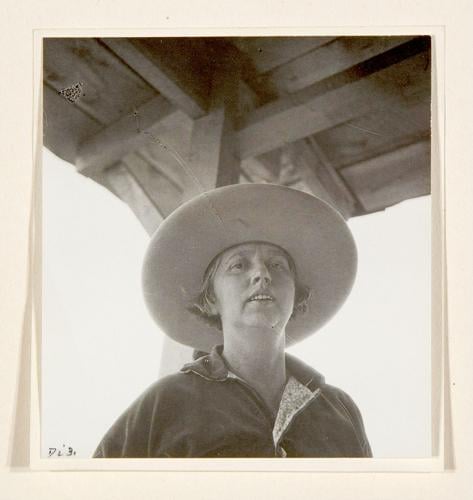The year – 1969. There were three major national television networks. No Internet. No social media. But there was radio. I stumbled onto an audio interview. The interviewer, a nameless DJ with a New York accent. The interviewee was none other than the British painter who’d become — thanks to D.H. Lawrence and Mable Dodge, and her own spirit of adventure — known as a Taos “Modernist,” Hon. Dorothy Eugenie Brett.
In answer to the interviewer’s question, “When did you first meet Lawrence?” Brett (in that sturdy voice we on this side of the pond recognize as a Britisher who is confidently sure of herself) explained as if it were yesterday, “In Hampstead. We had a little house in Hampstead. In 1914 — just when the war had started.”
“A young painter who had met [Lawrence] and was determined I should meet him. But I was scared. I was always scared of those people. Anyway —I went there to tea. It was a tiny little house. Tiny! It was incredible that Frieda could get into it. She was huge. But we had tea there and that started the whole thing.”
The interviewer was more interested in Brett’s relationship to D.H. Lawrence, who was already well-known, but had not yet come to Taos, than Brett’s own accomplishments. It was her studies at London’s Slade School of Art where she first met novelist Lawrence, and others in the Bloomsbury Group.
Born November 11, 1883 into a family of the British aristocracy, her later life in Taos — and eventually, in 1938, becoming an American citizen — must have seemed like stepping through a time warp into another world. Taos would be home until her death in August 1977.
“What was your opinion of [Lawrence] when you first met him?”
“We just clicked. Immediately. Immediately. We sat on a little bench in front of the fire, and we had a wonderful time. I think he had a great feeling of protection for me — I don’t know quite how to explain that.”
“So, you felt that from the very beginning?”
“Yes. He sort of took me under his wing.”
From “the very beginning,” Brett would visit with the Lawrences — who also lived in the London suburbs, not far from Brett’s “little Queen Anne house” — they would come to her place for tea. During the war — WWI — Lawrence went to Australia, and Brett, who’d done a portrait of Lawrence, continued painting celebrities.
“We didn’t see him until he came back — in 1924, it must have been.”
“1923,” the interviewer corrected.
“And then, he wanted four of us to come over. I was the only one who came over with him.”
“When he came back in 1923, he’d already been to Taos?” the interviewer asked.
“Oh yes! He’d been here. From Australia — he came here. And then, he went back to England — wanted to collect [other artists] and me. They all agreed to come but they backed out — except me.”
“Tell us what he wanted to do here, and why he wanted you all to come.”
“He wanted to form a little colony. You know — one of those idyllist colonies? Up at the ranch here. But of course, it failed. It would have failed anyway, you know. Those things always do. They never succeed.”
After coming to Taos in 1924, she was deeply befriended by D.H. and Frieda, and by Mabel Dodge — who was sometimes less than friendly. But at Mabel’s soirees, Brett would meet artists, writers and performers living in Taos or visiting from the East Coast or from across the big water, fascinated with the creative magic and landscape of Taos.
Brett would hesitantly begin painting Southwest scenes. She had seen “her first American Indian when she was five,” according to an Owings Gallery, Santa Fe, bio, “attending a performance in London of Buffalo Bill’s Wild West Show.”
Still, Brett was hesitant about portraying those she came to consider her deepest friends — as ‘noble savages” — although with their permission, she did support herself selling these images to tourists. She, Mabel Dodge and Frieda Lawrence were known in Taos society as the “Three Fates.”
Brett’s early works, from 1919 through 1958, including nude figures, landscapes and aristocratic portraits that can be seen on the TATE Museum website. Other works and her later New Mexico-themed art are housed at the Smithsonian American Art Museum in Washington, D.C., the New Mexico Museum of Art, Santa Fe, the Roswell Museum, Roswell, N.M. and in the Millicent Rogers Museum and the Harwood Museum of Art, both in Taos.























(0) comments
Welcome to the discussion.
Log In
All comment authors MUST use their real names. Posts that cannot be ascribed to a real person
will not be moderated.
Keep it Clean. Please avoid obscene, vulgar, lewd, racist or sexually-oriented language.
PLEASE TURN OFF YOUR CAPS LOCK.
Don't Threaten. Threats of harming another person will not be tolerated.
Be Truthful. Don't knowingly lie about anyone or anything.
Be Nice. No racism, sexism or any sort of -ism that is degrading to another person.
Be Proactive. Use the 'Report' link on each comment to let us know of abusive posts.
Share with Us. We'd love to hear eyewitness accounts, the history behind an article.